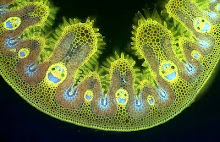Few shrubs are as easy to cultivate ("in almost any soil short of a bog": Graham Stuart Thomas) or provide such a reliable display of spring flowers as Forsythia, so it's hardly surprising that its blooms light up suburban gardens everywhere at this time of year. This fine specimen was flowering on the banks of the River Tyne at Wylam yesterday, with its mass of blooms contrasting with the still-leafless branches of the trees on the riverbank.
The modern Forsythia Forsythia x intermedia is a hybrid between F. suspensa and F. viridissima, first produced in the 1880s and since reproduced with various improvements on numerous occasions by intercrossing these two species, both originating from China. The parental species are not seen very often in cultivation these days. F. suspensa has long, trailing shoots that William Robinson, in his English Flower Garden (1883), suggested looked best when they were either trailed over a sunny wall or secured to it (when "the long, slender branchlets dispose themselves in a very graceful manner"). It flowers all along its shoots, so to achieve the best display of blooms at least some of the long shoots should not be pruned. In contrast the hybrid, which inherits its shrubby stature from F. viridissima, flowers on side shoots, so some shortening of long shoots immediately after flowering keeps the plant reasonably compact and still guarantees a mass of golden blooms in the following spring; I've seen some very striking, quite formal flowering hedges created with this species.
An important factor in the popularity of Forsythia is that its flower buds are not damaged by hard frosts in March. Some research at Purdue University back in 1995 indicated that this was at least partly due to the fact that the flower tissues accumulate soluble sugars, that protect the cells from catastrophic effects of freezing.
It's quite often stated that Forsythia flowers contain the carbohydrate lactose, which is otherwise only found in milk secreted by the mammary glands of mammals. I'm not sure how this claim originated, but a study by biochemists at Tohoku University in Japan in 1991 failed to find any trace of lactose in the flowers.
Interestingly, in 1998 genetic engineers at the National Institute for Agrobiological Resources at Ibaraki in Japan managed to express mammalian milk proteins in tobacco plants, for potential pharmaceutical applications - a biochemical feat that half a billion years of plant evolution failed to achieve.















